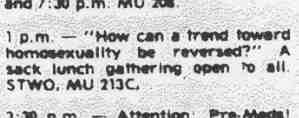
PHOTO: (click photo to enlarge) Jack Baker and Michael McConnell were married May 18, 1970 in Minnesota when the state marriage law did not specify opposite-sex couples. Their story was featured in an article by Jack Star, "The Homosexual Couple, As far as Jack Baker and Michael McConnell are concerned, their relationship "is just like being married," Look magazine, Jan. 26, 1971, p. 69 (yes, that is the real page number -- I bet some editor thought it was a wonderful in-joke.) The cover of that issue featured multiple stories on "The American Family," including "'Married' homosexuals." Look magazine was a competitor to Life magazine before both went out of business after advertising dollars shifted to television. Both Life and Look provided large-format photographs of current news events. For years the cover price was 10 cents and subscriptions were virtually free, which resulted in a mass circulation of it to millions of readers across America. School children often clipped photos out of these magazines for school projects. (See my previous post Jack Baker 1971 Look magazine gay marriage story (7/23/09))
The gay marriage pioneer Jack Baker has been largely ignored by gay historians. The reasons are not clear whether it is because mainstream publishers in New York focused on what they knew best, or if it was due to back East elitism on their part to ignore the Midwest, or if it was because, as some gay historians told me, that the historians personally had political objections to gay marriage activism and Baker was "not willing to cooperate with them on writing a history." Other people told me that Baker had simply burned out of the politics of gay activism and retreated to focusing on his law practice. What ever the truth might be, Baker is now 70 years old and retired. Jack Baker has started a new "Now is the time" blog by Jack Baker, Esq. (NOTE UPDATE: April 9, 2012: I confirmed this really is a blog by Jack Baker, not a scam, by sending him a letter via the U.S. mail and I got a reply directly from Jack Baker via the U.S. mail confirming it is his blog. He said he was trying to learn Web design and said he had also noticed the serious problems with his blog template and formatting codes, which make it almost impossible to see with a standard Windows Internet Explorer browser.)
I am quoted in one of Jack Bakers' first blog posts "'Gay marriage - a retrospective' on the 'Now is the time,' a blog by Jack Baker, Esq' (Posted Mar. 2012 accessed April 4, 2012). Baker quotes my previous online article that I wrote for Jack Nichols's newspaper: "Jack Baker & Michael McConnell: Lunatics or Geniuses?" published June 21, 2004. My thesis is based on the fact that gay marriage activism was rejected by early gay activists who were mostly interested in sexual freedom and gay liberation. I argued that Jack Baker was a genius to see that gay marriage would become the litmus test for gay equality decades later because nearly all other gay activists angrily dismissed gay marriage as being contrary to the goals of gay liberation and even mainstream gay organizations worked against it back then.
My article was based both on my own experience at the University of Minnesota in and on the history that Jack Baker had cooperated with the writing of it by Ken Bronson, A Quest for Full Equality (2004), (PDF) available online from Quatrefoil Library, accessed Apr. 4, 2012. Note that this PDF was originally published on a custom domain that appears to be dead today: Ken Bronson, "A Quest for Full Equality," www.may-18-1970.org self-published May 18, 2004, p. 6-7, 48 (PDF) from Ken Bronson's Web site www.may-18-1970.org on Jack Baker's marriage. For a certified archived copy go to the Internet Archive Way Back Machine and view a copy of the Contents Page for www.may-18-1970.org that has a link to the PDF filename Quest.pdf that was archived May 10, 2006. (See previous post Life Magazine gay marriage 1971 (11/20/08) and my Jack Nichols Gay Today Archive (9/12/09))
More recently I published a history of Jack Baker's connection to the history I wrote about "Corvallis, Oregon State University gay activism 1969-2004," published at OutHistory.org 2010
For a short overview history, see Jack Baker (activist) From Wikipedia, the free encyclopedia.
A complete and accurate history of Jack Baker's gay marriage activism is by Ken Bronson, A Quest for Full Equality (2004), (PDF) available online from Quatrefoil Library.
Other good historical archives with information about Jack Baker include University of Minnesota, The Jean-Nickolaus Tretter Collection in Gay, Lesbian, Bisexual and Transgender Studies -- see The Jean-Nickolaus Tretter Collection, Outhitory.org (See previous post Magnus Hirschfeld, Jack Baker, University of Minnesota and Oregon State University gay connection (1/21/12))
Here are links to some pages on the OutHistory.org site that are related to Minnesota and Jack Baker:

PHOTO: May 18, 1970 Michael McConnell and Jack Baker were married by Hennepin County Minnesota Justice of the Peace. (See Ken Bronson, A Quest for Full Equality (2004), available online from Quatrefoil Library -- this was originally on a now dead Web site by Ken Bronson, "A Quest for Full Equality," www.may-18-1970.org self-published May 18, 2004, p. 6-7, 48 (PDF). (See my previous post Life Magazine gay marriage 1971 (11/20/08))
 PHOTO: Reverend Troy Perry of the Metropolitan Community Church conducting a same-sex marriage ceremony in 1971. Google photo collection from article "Homosexuals in revolt: The year that one liberation movement turned militant," Life Magazine, Dec. 31, 1971, p. 70. (See my previous post Life Magazine gay marriage 1971 (11/20/08))
PHOTO: Reverend Troy Perry of the Metropolitan Community Church conducting a same-sex marriage ceremony in 1971. Google photo collection from article "Homosexuals in revolt: The year that one liberation movement turned militant," Life Magazine, Dec. 31, 1971, p. 70. (See my previous post Life Magazine gay marriage 1971 (11/20/08))

PHOTO: Cover of the Oct. 31, 1969 Time Magazine featuring the cover story written by Contributing Editor Christopher Cory, researched by Madeleine Berry, and reported by Ruth Galvin, "The Homosexual in America," Time Magazine, Oct. 31, 1969, p. 56-67 (See contents for Time magazine, Oct. 31, 1969, Vol. 94 No. 18, p. 9). This issue appeared on newsstands and in school libraries, used by children, just a few months after the gay bar Stonewall riot occurred in Greenwich Village, New York. Stonewall is often used to mark the start of the modern gay rights movement even though homophile groups preceded it. The brightly colored cover photo was modified using the "posterization effect" that was created by a then newly popular graphic arts photo biography printing process. It echoed the modern pop art paintings and artwork of the closeted asexual or gay artist Andy Warhol who became popular in the 1960s mass media. Frank Kameny, who was a homophile activist and member of the Mattachine Society (a pioneering gay rights group formed in the 1950s), was included as part of "A Discussion: Are Homosexual sick?" sidebar to Time magazine cover story, "The Homosexual in America," Oct. 31, 1969, p. 66-67. (See previous post Pre-Stonewall gay activist Frank Kameny dies - was he a hero? (10/19/11)..) Also included in this issue was a sidebar "Four Lives in the Gay World," Time magazine, Oct. 31, 1969, p. 62 and an introduction to the issue written by Henry Luce III, "A Letter From The Publisher: Time magazine, Oct. 31, 1969," p. 9 who comments on the cover story by writing, "It deals with one of the most delicate issues of the day: homosexuality in American society. Once taboo, it is now the subject of debate and concern. Yet, as Cory says, 'Basically it is still a topic that is explained piecemeal and in polemics. Like all study about sex, large-scale homosexuality research is really just beginning. And the findings seem to knock down many of the stereotypes.' [At the end of the publisher's letter is a note that says] The Cover: Color-key montage by Fred Burrell. The face and figure are those of a young homosexual who agreed to pose for the photographer." (See my previous post Gay marriage discussed in 1969 Time magazine cover story (11/1/11))
Here are links to some of Jack Baker's first blog posts:
- Stalling for Justice from Jack Baker Now is the time by Jack Baker, Esq
- "Biography of Jack Baker, Esq." "Now is the time" blog by Jack Baker, Esq, posted March 2012 says, "How to contact me, P.O. Box 8661. Minneapolis, MN 55408"
- "Gay marriage is inevitable," from Jack Baker Now is the time by Jack Baker, Esq. posted Mar. 2012
- "Gay marriage - a retrospective," from Jack Baker Now is the time by Jack Baker, Esq.
- "Related Articles," from Jack Baker Now is the time by Jack Baker, Esq. posted Mar. 2012
- "Justices for Sale," from Jack Baker Now is the time," by Jack Baker, Esq, posted Mar. 2012








